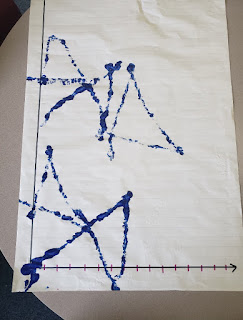This year, I was fortunate enough to collaborate with my amazing Teacher-Librarian to teach my Grade 6 students about Spheros.
What are spheros?
Spheros are spherical robots that are great for beginners because they are very durable! The library doors were open one day and one of my students made an error in her program and the sphero raced out the door, down the stairs, and ended up behind a vending machine!
How did we use spheros?
I'm not an expert in robotics, but luckily for me (and my students), our Teacher-Librarian is. She began working with my class once a week on programming in a variety of lessons, which culminated in our students working in partners to program the spheros to reach specific coordinates on a coordinate plane.
This group decided to make a right angle triangle with their sphero. You can see where they marked the page with their attempted coordinates, and they were very close to their goal!
Once the students were pretty sure their program was accurate, we dipped the spheros in paint and recorded their journeys.
What did we learn?
As you can see from the photos, many groups tried several times with the paint because the paths were not as expected. We didn't account for the extra resistance that the paint would have on the spheros, and a lot of the kids were disappointed that their paint trials weren't as accurate as their original trials.
However, there was so much discussion and conversation between the partners, and they were using scientific and mathematical language without realizing it. Our principal joined us for the paint day and was super impressed with the level of conversation of these Grade 6 students.
This project fit in so many curricular areas in BC, including ADST (applied Design, Skills, and Technology), Career Education, and Math. The main outcomes we kept coming back to were from Science:
- Identify possible sources of error
- Co-operatively design projects
- Suggest improvements to their investigation methods
My takeaways
I will definitely try this again, but I think I will need to give them more time. Each week, we had one block of about 45 minutes in the library, but by the end of that block, some teams were just figuring out their codes. In the future, I would give at least 1-1.5 hour blocks to this project so that the students who need more time can have it, and the students who catch on quickly can try another challenge.
I also wish we had more time to try the painting again after they realized the resistance and drag of the paint, but we didn't have any more library blocks.
It would be great to let the kids come up with their own challenges or challenges for their classmates, as well.
Where to go next?
A Grade 8 teacher in my school also used Spheros with her class. For them, the challenge was to draw an X-House in one continuous line. This could be a challenge for my Grade 6s who finish quickly. Here's a look at one group of Grade 8s!
I'd love to hear how you use Spheros with your middle schoolers! Let me know in the comments below!









Comments
Post a Comment